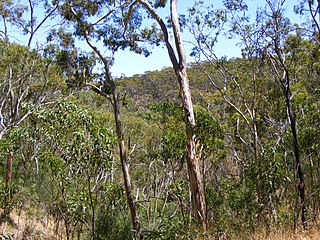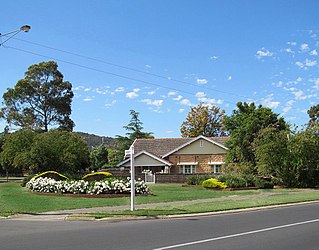
Belair National Park is a protected area in Belair, South Australia, 9 kilometres southeast of Adelaide city centre; it covers an area of 835 hectares. It was proclaimed in 1891 and was the first national park in South Australia, second in Australia and the tenth in the world. The national park lies within the Adelaide Hills and Mitcham council area, and forms part of a chain of protected areas located along the Adelaide Hills Face Zone. The national park is administered by the Department of Environment, Water and Natural Resources.

Mitcham railway station is located on the Belair line in Adelaide. Situated 8.5 kilometres from Adelaide station, it is in the suburb of Lower Mitcham.
Torrens Park is a mainly residential large inner-southern suburb of Adelaide, incorporating some of the foothills and adjacent to the original "Mitcham Village". It was named after Sir Robert Richard Torrens, the instigator of the Torrens title system of land registration and transfer, who built a large home in the area which he named Torrens Park.

Colonel Light Gardens is a suburb located within the Australian City of Mitcham in the greater Adelaide region, approximately 7 km (4 mi) south of the Adelaide city centre. The area is 1.58 km2 (0.61 sq mi). Planned as a garden suburb, it is known for wide, tree-lined streets, presentable postwar bungalow homes, rounded street corners, and much manicured, well maintained open space.

The City of Mitcham is a local government area in the foothills of southern Adelaide, South Australia. Within its bounds is Flinders University, South Australia's third largest, and the notable, affluent suburb of Springfield which contains some of the city's most expensive properties.
Upper Sturt is a suburb in the inner south of Adelaide, South Australia. The suburb is nestled in the lower reaches of the Mount Lofty Ranges with the Western Half located in the City of Mitcham local government area, and the eastern portion located in the Adelaide Hills Council Local Government Area.
Westbourne Park is an inner southern suburb of Adelaide, the State capital of South Australia. The suburb was named after Westbourne, a village in Sussex, England, and was laid out in 1881.

The Belair line is a suburban rail commuter route in the city of Adelaide, South Australia, that runs from the Adelaide station to Belair in the Adelaide Hills via the Adelaide-Wolseley line using diesel 3000/3100 class railcars. Prior to 1995, this part of Adelaide-Wolseley was a two-track broad gauge line. In 1995, Adelaide-Wolseley was converted to standard gauge meaning Adelaide to Belair is now effectively two separate single-track lines running in parallel: the Belair commuter line and the Adelaide-Wolseley standard gauge freight line.

Bedford Park is a southern suburb of Adelaide in South Australia.

Blackwood is a south-eastern suburb located in the foothills of Adelaide, South Australia. It is part of the local government area of the City of Mitcham.
Clapham, located approximately 8 kilometres (5.0 mi) south of the Adelaide city centre, is a primarily residential suburb situated within the City of Mitcham, incorporating some of the foothills. The suburb is named after Clapham in London, England. Neighbouring suburbs are Colonel Light Gardens, Panorama, Lynton, Torrens Park and Lower Mitcham.
Kingswood is a suburb of the Australian city of Adelaide in the City of Mitcham.
Hawthorn is a suburb of Adelaide, South Australia, in the City of Mitcham. It is bounded to the north by Cross Road, to the south by Grange Road, to the west by Sussex Terrace and to the east by Belair Road. The Belair train line runs through the suburb. To the west is Westbourne Park, and to the east is Kingswood.
Eden Hills is a south eastern suburb located in the foothills of Adelaide, South Australia. It is part of the local government area of the City of Mitcham.

Brown Hill Creek is a south-eastern suburb of Adelaide in the City of Mitcham in South Australia, named in 1991 after Brown Hill Creek which flows from east to west through the locality. The creek itself was named after Brown Hill which rises immediately south-east of Mitcham village.
Coromandel Valley is a semirural south-eastern suburb of Adelaide, South Australia. It straddles the City of Mitcham and the City of Onkaparinga council areas, with the Sturt River being the boundary between the two council areas.
Lower Mitcham is an inner southern suburb of Adelaide, South Australia in the local government area of Mitcham. To the north, it is bounded by Grange Road, to the east by Belair Road, to the south by Murray Street. To the west, the suburb is bordered by a line running from Murray Street along View Street and continuing north to Grange Road.

Craigburn Farm is a suburb of Adelaide, South Australia, Australia. It is located about 17 km by road south of the city centre.
Glenalta is a suburb located in the south eastern Foothills of the Mount Lofty Ranges of Adelaide, South Australia. It is adjacent to Belair National Park.
Crafers West is a suburb of Adelaide in the Adelaide Hills Council. Located on Peramangk land, it was formally named in 1985 as a separate address from Crafers. Crafers West contains the headwaters of Brown Hill Creek and is dominated by steep terrain and native scrub. It is bounded by Mount Barker Road on the northeast and the Bridgewater railway line on the south. The Eagle Mountain Bike Park is in the north of the suburb. Popular tourist spots include Clealand Conservation Park, Mt Lofty Botanic Gardens, and Belair National Park Holiday Park.












